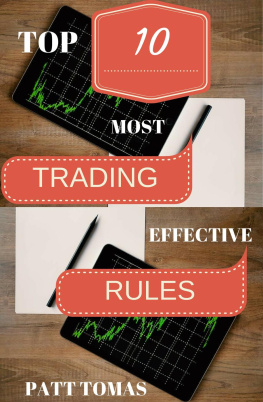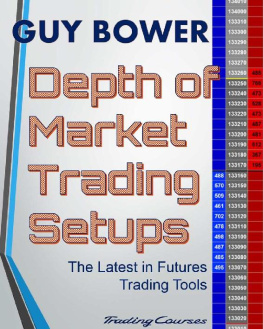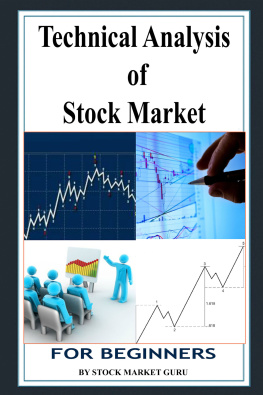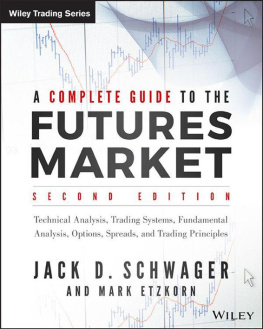TRADE YOUR WAY TO FINANCIAL FREEDOM
TRADE YOUR WAY TO FINANCIAL FREEDOM
SECONDE DITION
VAN K. THARP


Copyright 2007 by Lake Lucerne Limited Partnership. All rights reserved. Except as permitted under the United States Copyright Act of 1976, no part of this publication may be reproduced or distributed in any form or by any means, or stored in a database or retrieval system, without the prior written permission of the publisher.
ISBN: 978-0-07-165813-3
MHID: 0-07-165813-0
The material in this eBook also appears in the print version of this title: ISBN ISBN: 978-0-07-147871-7, MHID: 0-07-147871-X.
All trademarks are trademarks of their respective owners. Rather than put a trademark symbol after every occurrence of a trademarked name, we use names in an editorial fashion only, and to the benefit of the trademark owner, with no intention of infringement of the trademark. Where such designations appear in this book, they have been printed with initial caps.
From a Declaration of Principles jointly adopted by a Committee of the American Bar Association and a Committee of Publishers
McGraw-Hill eBooks are available at special quantity discounts to use as premiums and sales promotions, or for use in corporate training programs. To contact a representative please visit the Contact Us page at www.mhprofessional.com .
TERMS OF USE
This is a copyrighted work and The McGraw-Hill Companies, Inc. (McGraw-Hill) and its licensors reserve all rights in and to the work. Use of this work is subject to these terms. Except as permitted under the Copyright Act of 1976 and the right to store and retrieve one copy of the work, you may not decompile, disassemble, reverse engineer, reproduce, modify, create derivative works based upon, transmit, distribute, disseminate, sell, publish or sublicense the work or any part of it without McGraw-Hills prior consent. You may use the work for your own noncommercial and personal use; any other use of the work is strictly prohibited. Your right to use the work may be terminated if you fail to comply with these terms.
THE WORK IS PROVIDED AS IS. McGRAW-HILL AND ITS LICENSORS MAKE NO GUARANTEES OR WARRANTIES AS TO THE ACCURACY, ADEQUACY OR COMPLETENESS OF OR RESULTS TO BE OBTAINED FROM USING THE WORK, INCLUDING ANY INFORMATION THAT CAN BE ACCESSED THROUGH THE WORK VIA HYPERLINK OR OTHERWISE, AND EXPRESSLY DISCLAIM ANY WARRANTY, EXPRESS OR IMPLIED, INCLUDING BUT NOT LIMITED TO IMPLIED WARRANTIES OF MERCHANTABILITY OR FITNESS FOR A PARTICULAR PURPOSE. McGraw-Hill and its licensors do not warrant or guarantee that the functions contained in the work will meet your requirements or that its operation will be uninterrupted or error free. Neither McGraw-Hill nor its licensors shall be liable to you or anyone else for any inaccuracy, error or omission, regardless of cause, in the work or for any damages resulting therefrom. McGraw-Hill has no responsibility for the content of any information accessed through the work. Under no circumstances shall McGraw-Hill and/or its licensors be liable for any indirect, incidental, special, punitive, consequential or similar damages that result from the use of or inability to use the work, even if any of them has been advised of the possibility of such damages. This limitation of liability shall apply to any claim or cause whatsoever whether such claim or cause arises in contract, tort or otherwise.
We hope you enjoy this McGraw-Hill eBook! If youd like more information about this book, its author, or related books and websites, please click here.
This book is dedicated to my wife, Kalavathi Tharp.
Kala provides a very special spark in my life.
Without that spark and her tremendous love,
this book would not be possible.
CONTENTS
PART ONE
THE MOST IMPORTANT FACTOR IN YOUR SUCCESS: YOU!
Chapter 1
The Legend of the Holy Grail
Chapter 2
Judgmental Biases: Why Mastering the Markets Is So Difficult for Most People
Chapter 3
Setting Your Objectives
PART TWO
CONCEPTUALIZING YOUR SYSTEM
Chapter 4
Steps to Developing a System
Chapter 5
Selecting a Concept That Works
Chapter 6
Trading Strategies That Fit the Big Picture
Chapter 7
Six Keys to a Great Trading System
PART THREE
UNDERSTANDING THE KEY PARTS OF YOUR SYSTEM
Chapter 8
Using Setups to Jumpstart Your System
Chapter 9
Entry or Market Timing
Chapter 10
Knowing When to Fold Em: How to Protect Your Capital
Chapter 11
How to Take Profits
PART FOUR
PUTTING IT ALL TOGETHER
Chapter 12
Theres Money for Everyone
Chapter 13
Evaluating Your System
Chapter 14
Position Sizingthe Key to Meeting Your Objectives
Chapter 15
Conclusion
FOREWORD
Let me start by saying that Trade Your Way to Financial Freedom is required reading for all of my new traders. Of all of Dr. Van Tharps published books, this one gives the essence of his teachings from his workshops and home study courses. My name is Chuck Whitman, and I am the CEO of Infinium Capital Management, a proprietary trading firm located in the Chicago Board of Trade. We currently have 90 employees, trade on 15 different exchanges, and trade underlying instruments and options on all asset classes. I have personally purchased many copies of this book, but before I get into that, let me tell you about my experiences with Van Tharp.
I first became aware of Vans teachings in 1998, when one of my mentors, Bruce, obtained two of Vans home study courses, the Peak Performance Course for Traders and Investors and the Developing a Winning System That Fits You Course. Later, Bruce also attended one of Vans System seminars, and he came back telling me how impressed he was with the material and the quality of students that had attended the seminar.
At that time, I was in the midst of one of the most difficult periods of trading of my career. Ironically, 1997 was one of my most successful trading years, and in 1998 I had decided to commit myself to becoming absolutely the best trader I could be. However, the only approach I knew was to do more so I could hit my new revenue goal, and needless to say, I was overtrading and battling huge profit and loss swings in my account. In the fall of 1998, I put on a large trade that conceptually was a great trade. However, I mismanaged the trade, and it quickly spiraled into one of the largest losses of my career. Looking back at it now, Id made many mistakes, and this is according to Vans definition of a mistake which is not following my rules. I had not done any scenario planning before the trade, and I found myself in a position with a terrible reward-to-risk ratio. Furthermore, as I battled the loss, I responded emotionally and did everything I could to prevent it. Its what Van calls the loss trap. Instead of just taking a small loss, I struggled with it, trying to avoid it. And the more I struggled with the loss, the worse it became. And the bigger it got, the more I wanted to avoid it and not take it. Eventually, the loss became too painful and I liquidated the trade. The moment I was out of the trade, I made a vow that I was going to learn from what I had been through and make sure I would never repeat it. It turned out to be a major turning point in my trading career.
Next page








